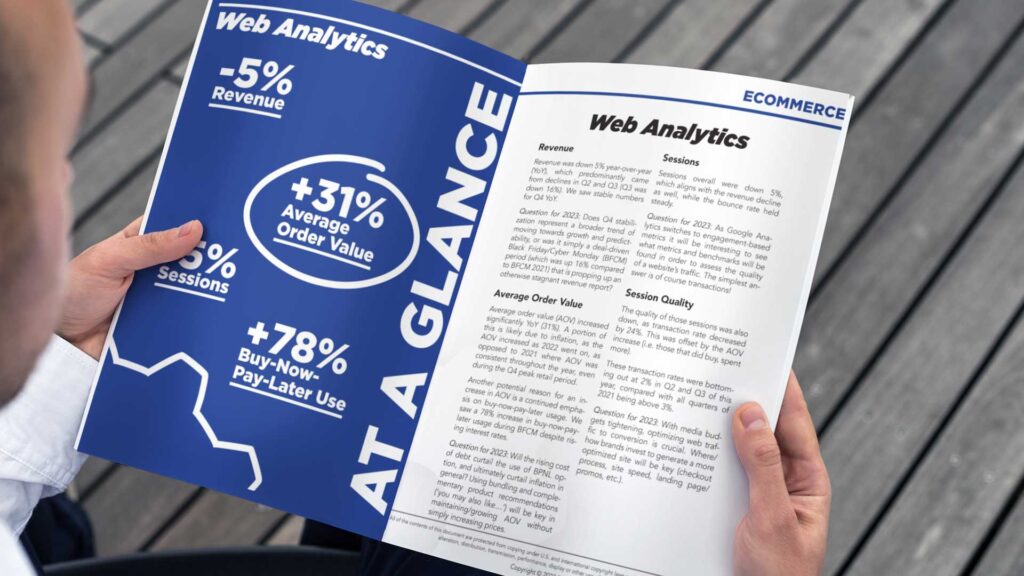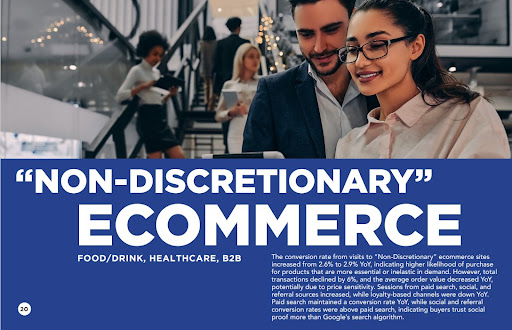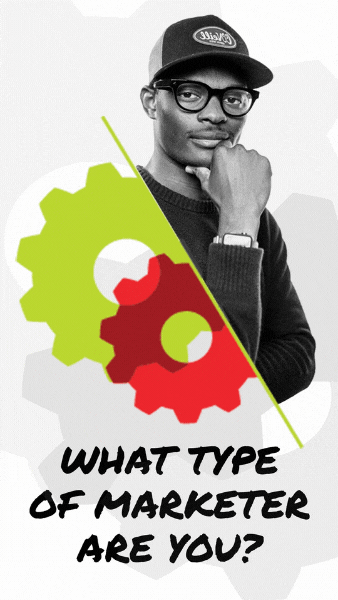

2022 was not an easy year, with a lot of declines in key metrics, particularly in the middle of the year. Q4 gave us a reason for optimism though, so will the momentum keep going or will 2023 continue financial uncertainty?
Last year was a watershed moment in the history of ecommerce. While the 2010s saw the rapid expansion of online shopping thanks to developments in mobile devices, the expansion of social media influence, and a massive shift in consumer behavior, this decade will see an even greater change thanks to AI.
Here’s what we found.
How We Aggregate:
Hawke Media uses the data from its proprietary marketing technology platform, HawkeAI. HawkeAI aggregates data across 1000s of businesses’ marketing channels and $100’s of millions in annual media spend to compile these data benchmarks.
Ecommerce Businesses:


Web Analytics
- Revenue was down 5% YoY, which predominantly came from declines in Q2 and Q3 (Q3 was down 16%). We saw stable numbers for Q4 YoY.
- Question for 2023: Does Q4 stabilization represent a broader trend of moving towards growth and predictability, or was it simply a deal-driven BFCM period (which was up 16% compared to BFCM 2021) that is propping up an otherwise stagnant revenue report?
- Average order value (AOV) increased significantly YoY (31%). A portion of this is likely due to inflation, as the AOV increased as 2022 went on, as opposed to 2021 where AOV was consistent throughout the year, even during the Q4 peak retail period.
- Another potential reason for an increase in AOV is a continued emphasis on buy-now-pay-later usage. We saw a 78% increase in buy-now-pay-later usage during BFCM despite rising interest rates.
- Question for 2023: Will the rising cost of debt curtail the use of BPNL option, and ultimately curtail inflation in general? Using bundling and complementary product recommendations (‘you may also like…’) will be key in maintaining/growing AOV without simply increasing prices.
- Sessions overall were down 5%, which aligns with the revenue decline as well, while the bounce rate held steady.
- Question for 2023: As Google Analytics switches to engagement-based metrics it will be interesting to see what metrics and benchmarks will be found in order to assess the quality of a website’s traffic. The simplest answer is of course transactions!
- The quality of those sessions was also down, as transaction rate decreased by 24%. This was offset by the AOV increase (i.e. those that did buy, spent more). These transaction rates were bottoming out at 2% in Q2 and Q3 of this year, compared with all quarters of 2021 being above 3%.
- Question for 2023: With media budgets tightening, optimizing web traffic to conversion is crucial. Where/how brands invest to generate a more optimized site will be key (checkout process, site speed, landing page/promos, etc.).
Organic Channels
- Email marketing saw a gradual decline over the course of 2022 on multiple performance metrics, including both quantity of sessions and quality of sessions. Total sessions from email declined 12% but were flat for most of the year until Q4. Similarly, transaction rates on email declined from 4% to 3% YoY.
- Question for 2023: With these declining results, how can brands attract new email sign-ups and tailor content to not see high unsubscribe rates?
- Organic social content also took a hit this year, with both sessions and transaction rates down. Sessions particularly have been on a steady decline since the start of 2021, decreasing almost every quarter (except for Q4 naturally). This could be indicative of either less content being produced, or audiences that are more particular or selective in what they click on as pandemic restrictions lift and people are not surfing social media the same. Of course, the other possibility is a continued challenge in attribution from various updates to tracking.
- Affiliate was a bright spot for 2022, with a 16% increase in sessions and a 35% increase in transactions.
Paid Channels
- Google Ads
- Spend YoY increased 3%, but distribution was very different
- 2021 saw a linear increase quarter over quarter in spend
- 2022 saw a significant drop off in Q3, and while Q4 increased over Q3, Q4 YoY was down 15%
- Media budgets were definitely impact by economic climate and lifting of restrictions
- Question for 2023: with a year of hopefully no restrictions, and continued economic uncertainty, where will ‘the bottom’ be in terms of spend, when will we see the ramp up?
- Clicks moved in line with spend (up 4%), with predictability/steadiness in CPCs YoY, which is helpful for forecasting in uncertain times. Using a ‘bottom-up’ approach of starting with a CPC type metric to establish sessions expected from Google is likely more reliable than doing a ‘top-down’ approach to forecasting (i.e. where are we going to generate $X of revenue from)
- Eyeballs got more expensive on key visual networks for Google (YouTube and Display), with increases of around 30% in CPMs on those networks. Ultimately both also had lower conversion rates (approx. 15% drop in conversion rates on both).
- These CPMs are still lower than the typical social media platforms, so they still represent a cost-effective option to generate impressions.
- Spend YoY increased 3%, but distribution was very different
- Meta Ads
- Meta Ad spending also increased 4% YoY, but was more linear in growth, with spend increasing each quarter over quarter in 2022.
- Meta Ads also sees a more significant drop off from Q4 to Q1 than Google (Facebook dropped off 14%, Google dropped 4%). This is likely indicative of more seasonality in spending on Meta Ads during peak retail, whereas Google is seen as more of the ‘baseline’ spend to capture highest intent.
- Question for 2023: Will we see this same drop off in spend in Facebook Q1 this year as last year, or will the positive CPMs/CPCs from Q4 on Facebook mean advertisers stay with the platform?
- The increase in spend on Facebook was almost entirely due to a YoY increase in Facebook spend in Q4, while the rest of the year was mostly flat. This is likely the result of the 64% and 47% YoY increases we saw in spending on TikTok and Pinterest respectively.
- Question for 2023: How much of the diversification of social media advertising will continue? The numbers would suggest that any new budgets are being allocated to these new platforms and that Google and Facebook budgets are being treated as optimized/maxed-out.
- Other platforms
- CPMs on TikTok and Pinterest are increasing as more budget shifts to these platforms. For example, CPMs on TikTok increased from $4 to $8 YoY. The CPAs still though are lower than Meta, so until those become more aligned it is likely that these platforms will take more of any increases in ad spend.
- Question: When will these platforms reach the saturation point and competition of Meta and Google? Based on these trends, we would expect to see that by end of 2023.
- CPMs on TikTok and Pinterest are increasing as more budget shifts to these platforms. For example, CPMs on TikTok increased from $4 to $8 YoY. The CPAs still though are lower than Meta, so until those become more aligned it is likely that these platforms will take more of any increases in ad spend.
“Non-discretionary” Ecommerce:
Includes: food/drink, healthcare, B2B


Web Analytics
- The conversion rate from visits to the site increased from 2.6% 2.9% YoY. This is indicative of two key points:
- Once people land on a site with products of this nature (i.e. items that are more essential or inelastic in demand), they have a higher likelihood of purchasing than sites with more discretionary products, which had a conversion rate of 2.2% in 2022).
- There were also fewer sessions for website selling these products, so while conversion rates were up, total transactions declined by 6%.
- Another telling piece of information is the average order value declined YoY, so even though those sessions had higher intent to purchase, the average sale was worth less. This is potentially due to price sensitivity from economic conditions where these products are needed but easily substituted for a lower cost alternative.
Organic & Paid Channels
- To support the idea of shoppers looking for lower cost alternatives, we saw an interesting trend in where sessions came from.
- Typically more ‘loyalty’ based channels such as email, direct, (i.e. someone opens a browser and goes to that page), and organic search were all down YoY.
- Conversely, sessions increased from paid search, social and referral sources. These channels can typically be attributed to more people searching out for new alternatives, as opposed to just automatically buying from known brands.
- Unsurprisingly, conversion rates associated with the more loyalty based channels stayed consistent, with all of them staying within .2% of their previous year number (i.e. someone who clicks on an email from a brand they know were just as likely to buy from that brand in 2021 as 2022, but fewer people were clicking in the first place).
- Also perhaps unsurprisingly, but validates the conclusions above, is that the ‘browsing’ channels of social and referral that drove more traffic, saw declines in conversion rates as more people were searching out new buying options.
- The channel that bucked this trend was paid search, which saw sessions go up 8% and still maintained a conversion rate YoY (3.6%)
- That said, social and referral conversion rates, while down from 2021, were still above paid search (both around 5.5%).
- This could be an indicator that buyers looking for alternatives ‘trust’ or find better recommendations from those social or referral sources than a plain old google search (i.e. perhaps they trust social proof more than google’s search algorithm)
“Discretionary” Ecommerce:
Includes: arts/entertainment, beauty, fitness, home and garden and apparel)
Web Analytics
- discretionary products, which had a conversion rate drop from 2.5% (which was in line with non-discretionary in 2021) down to 2.2% in 2022.
- This makes sense given the economic climate that buyers are going to ‘shop around’ and also makes sense that discretionary items are purchased less frequently than non-discretionary
- BUT, what is striking within the data is that the average order value of purchasing discretionary items went up by 20%, so while conversion rates dropped, those that bought spent more money. As discussed above, there are a few possibilities for this, including buy-now-pay-later usage.
- This is especially interesting since the spike in AOV is heavily skewed to Q4 of this year. AOV was up 41% in Q4 of 2022 compared to Q4 of 2021, which cannot be explained away by inflation. For Q1+Q2 2022, AOV was only up 9% compared to Q1+Q2 2021, which is very closely correlated with inflation rates (around 7% YoY).
- Question for 2023: Was this spike in Q4 pent up demand from people tightening spending the rest of the year, or is this going to continue?
Organic Channels
- The only channel that saw an increase in sessions and transactions was affiliates. Given the discretionary nature of these products, it likely makes sense that affiliate marketing performs well since affiliate marketing predicates itself on social proof, testimonials, and are often more creative in nature from a copy/visual perspective.
- Email had an interesting mix in that sessions were actually up, but revenue and transactions were down. So, unlike non-discretionary goods, consumers were still willing and active in engaging with emails, but were not able to be converted. The most telling stat to this point is that in Q4 2021 email had a conversion rate of 4.4%, and in Q4 2022 that fell all the way to 2.7%, meaning that shoppers were looking for the deals, and were more selective on what deals they actioned.
- This is substantiated by an AOV increase in Q4 2022 compared to Q4 2021 of 25%, so when they did find a deal they liked, they took action in a big way!
- Question for 2023: How often can full retail price be realized? Are shoppers only willing to pull the trigger on deals? How can you structure your sales/products to maximize average order value?
Paid Channels
- We saw declines in ad spending on both Facebook and Google, but Facebook’s was more significant (27% decline) vs Google (4% decline).
- Facebook did see improvements in CPM, CPC and CPA as a result of this decline in spend (less competition). As mentioned above, this spend was reallocated to other social platforms.
- What is interesting is conversions reported actually went up 7%, showing that Facebook had likely reached a point of diminishing returns and inefficient. By peeling back the spend a bit, the more efficient/likely buyers still engaged and bought.
- Question for 2023: are there more efficiencies to be gained by shifting spend, ro are the other platforms soon going to reach a tipping point of saturation themselves? Let this be a case study/lesson in the inefficiency of not diversifying your spend enough!
Lead-Generation Businesses
Quick note: the definition of a ‘goal completion’ or ‘conversion’ when it comes to lead-gen is greatly varying and subjective to each individual business.
Web Analytics
- Goal completions YoY for the first three quarters of the year were up a modest 6% until Q4 which was significantly higher (28%). This is impressive given sessions and bounce rates were relatively flat YoY. In other words, those that went, had intent as indicated by an increase in goal completion rate.
- Question for 2023: With the switch to Google Analytics 4, these benchmarks will become challenging to monitor and the definition of ‘goal completion’ will become morphed into event-based actions. No one really knows what will happen but having GA4 set-up and running on sites today is imperative to get some sense of baseline performance under the new system.
Organic Channel
- Visitors had more intent across multiple channels, which is the opposite of ecommerce trends. For lead-gen businesses, both email and social content generated more goal completions than 2021 (21% and 25% respectively). This is despite social having a 24% decline in sessions.
- Question: Is the decline in sessions due to tracking limitations? Or is it simply consumer sentiment?
- Ultimately, seeing the goal completions increasing is the key benchmark to look at.
Paid Channel
- Google Ads
- YoY was up 3% as well, but Q4 was the lowest spend since Q1 of 2021. This is despite very good results overall from the spending, with conversions from Google Ads improving YoY in every quarter of 2022.
- Question for 2023: What will be needed to ever get brands to invest heavier in Google Ads Network, or is there any appetite at all? Is it saturated? Results would suggest investing in it…Another trick though is performance max campaigns. While they are reporting increases in conversions on performance max campaigns, are those leads becoming sales at the point of sale or in your CRM? Marketers have seen mixed results from these campaigns to date.
- This concern is backed up by a reported 25% increase in conversion rate on cross-network campaigns, which has (artificially?) driven down CPAs by 36% YoY..
- Meta Ads
- Meta spend decreased 13% YoY, but this was dramatically split between the year. In the first half of 2022, the spend was very consistent with the spend in the first half of 2021. However, in the second half the spend declined 28% YoY. Those that stayed invested on the platform though did see declining CPMs (14% decrease) and CPCs (5%).
- Pinterest saw an increase in spend of 10%, and TikTok increased as well, which likely drove the decrease from Meta. Pinterest still does have a lower CPM than Meta ($6 compared to $7), but that gap has closed from $5 and $8 respectively last year. The gap in cost per click has also closed between TikTok/Pinterest and meta.
Lead-Generation Businesses – B2B specific
Quick note: the definition of a ‘goal completion’ or ‘conversion’ when it comes to lead-gen is greatly varying and subjective to each individual business.
Web Analytics & Organic Channels
- Despite the increase in paid media that we discuss below, sessions YoY were within 2% of last year’s total. This indicates that the spend did not have a significant impact on overall traffic.
- Goal completion rates as well were also down about 10%, which indicates that the increased spend and re-allocation of budget did not necessarily lead to higher quality traffic hitting the site.
- A B2B favorite for marketing is email of course. We did see a 13% increase in sessions that came from email, but a goal completion rate that declined by 25%. If the goal of email marketing is to generate brand awareness and engagement with the content that you are sharing (e.g. monthly newsletters, product updates, etc) then mission accomplished for B2B marketers this year, from a loyalty and engagement standpoint email worked!
- If you were trying to use email marketing to get prospects to fill out a lead gen form or activate a trial, then overall that is not what email performance was delivering.
- orOrganic search was a similar story in some regards, we saw an improving bounce rate on organic search sessions, so people were finding the content they wanted more often and engaging with it, but goal completion rate for organic search was down. Again, that ‘goal completion’ may not be the objective and with long sales cycles, etc it is tough to conclude on this but from a direct attribution perspective of someone read a blog and then signed up to be pitched services was not happening as frequently as I’m sure some marketers would like.
Paid Channel
- Let’s actually talk about LinkedIn here, since this is effectively the only category of businesses that care about it 🙂
- LinkedIn from an engagement with ads perspective did well in 2022. While media spend did increase by 25%, we saw a larger increase in clicks (i.e. CPC actually went down) and an improvement in click-through rate as well.
- To compare this to the movement in ‘conversions’ is tricky knowing that B2B sales cycles can be longer and the definition of a conversion stops at the website experience and rarely be truly connected back to the real source of truth for B2B companies, the almighty CRM!
- For what it’s worth, we did actually see conversions stay flat despite this increase in clicks.
- Across Google and Facebook we did also see increases in media spend. The google increase was spread across all google ad networks and not concentrated to any one tactic, indicating this was the bi-product of broadly applied budget changes and not a tactic or result specific re-allocation.
- Question for 2023: Will increased spending in digital continue in our new virtual norm, or as restrictions are lifted will spend get redirected back to the traditional B2B staples of trade shows and in-person sponsorships/networking?
- While spending did increase overall in 2022, it was not linear by any means. The increase was predominantly generated by increases in Q1 and Q2 2022 compared to 2021. For example, Google spending for H1 increased by 40% (remember Jan-June 2021 was still very much pandemic-restricted and plenty of uncertainty around supply chains, etc still existed). Conversely, H2 spending was flat YoY.
Overall, from 2022 there are a few takeaways:
- Customer Lifetime Value is more important than ever – with the cost of paid media increasing, it’s more important than ever to keep the customers you get. This means improving product/service quality, enhancing customer experience, and maintaining contact with customers between purchases by providing value-adding information through content.
- You MUST HAVE a cohesive and comprehensive marketing strategy – With AI tools increasing the productivity of marketing managers and allowing all marketers to produce content faster than ever while also managing paid media channels more effectively, the marketer that can produce the best overall strategy will win.
- You need to dial in ALL CHANNELS – As you can see with the data, the effectiveness of paid media, email marketing, and social media is shifting widely between platforms. This means that predicting which channel to focus on will be more difficult. The best marketers will need to both understand and execute cohesive campaigns that span multiple channels to ensure that their message gets through.
- Position your products as a “must-have” – Wallets are a little tighter, and decisions are being made on what is a “must-have” purchase, and what is a “nice-to-have”. In difficult economic times like we’re experiencing currently, customers are looking for what they can cut. The better you can position your products and services as necessary to the customer, the better off your bottom line will be. When in doubt, show how your products can do one or more of the big three for your customers: Save them time, Save (or make) them money, Improve their quality of life
- Get strategic about customer acquisition – With ROAS becoming less predictable and having potentially longer timelines before proving profitable, it’s a good idea to offset your customer acquisition costs by forming strategic partnerships, affiliates, and influencers who can provide new customers regularly at breakeven or better to remain cash flow positive.

















